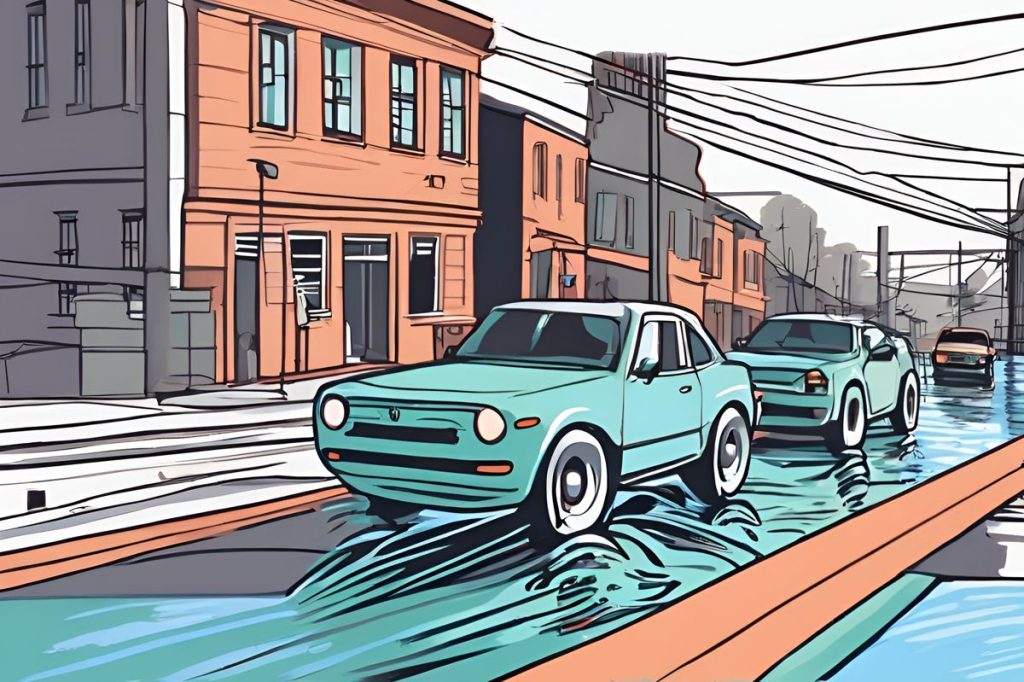Intense rainfall in Nicosia District led to treacherous road conditions, causing disruptions in central Nicosia and on major highways. Authorities urge drivers to reduce speed, maintain safe following distance, and increase visibility by keeping headlights on to navigate safely through the storm.
What safety measures should drivers take during intense rainfall in Nicosia District?
During intense rainfall in Nicosia District, drivers should:
– Reduce their speed for safety.
– Maintain a safe following distance from other vehicles.
– Keep headlights on to improve visibility.
– Exercise caution on slick roads and stay aware of the heightened risk of hydroplaning.
Navigating Through the Storm
Motorists found themselves navigating treacherous conditions as intense rainfall hit the Nicosia district on Monday. With prolonged showers, the roads became increasingly hazardous, the surfaces slick and visibility seriously impaired. The downpour, characterized by its sudden onset around 2 PM, led to disruptions particularly within central Nicosia and on arterial routes such as the Nicosia-Limassol highway, stretching to Lympia and Korfi, and on the Nicosia-Kokkinotrimithia highway extending to Astromeritis. Authorities have noted that while the rainfall is intense, the roads remain accessible, urging drivers to exercise caution.
Hailstorms also made an appearance, especially around the Troodos areas, compounding the already challenging driving conditions. With safety as a priority, the police have issued a statement advising travelers to reduce their speed, maintain a safe following distance from the vehicle ahead, and ensure their headlights remain on to increase visibility.
Weather Advisory and Safety Measures
The weather has a knack for reminding us of how quickly it can change the pace of our lives, especially when it leads to adverse driving conditions. In response to the current weather situation, a set of guidelines has been disseminated for those who find themselves on the road during these challenging times. The statement emphasized the importance of safe driving practices, the need for heightened awareness, and adherence to traffic regulations designed to protect everyone during such unpredictable weather patterns.
While the deluge has certainly brought certain inconveniences, it’s also a stark reminder of the powerful forces of nature and our need to remain prepared. It’s not only about adjusting our driving habits but also about being aware of the potential impact on infrastructure and the ability of emergency services to respond promptly during such events.
Impact on Daily Life and Future Precautions
This spell of intense weather is a disruption, affecting not just the flow of traffic but the rhythm of daily life. Commuters are experiencing delays, and outdoor plans are being rescheduled. The recent weather conditions serve as an impetus for local authorities to consider further investment in infrastructure that can withstand such weather extremes, from more efficient drainage systems to better-equipped emergency response units.
As the climate continues to show signs of volatility, the importance of being prepared for sudden changes in weather grows ever clearer. It calls for both individual readiness and a collective reevaluation of the systems we have in place to manage and respond to such meteorological challenges.
Weather Patterns and Climate Considerations
The intensity of this weather event is consistent with broader shifts in climate patterns that are being observed globally. Scientists have been pointing to the increase in extreme weather events as a clear signal of climate change. It underscores the need for robust urban planning that takes into account the growing frequency of extreme weather events.
The community’s resilience to such conditions lies not only in the immediate response but also in long-term planning and investment in infrastructure. It highlights the dual necessity of adapting to the present challenges while also looking ahead to mitigate future risks. Cities around the world are recognizing this and are beginning to implement strategies to enhance their weather preparedness and emergency response capabilities.
How did the intense rainfall in Nicosia District affect traffic?
Intense rainfall in Nicosia District led to treacherous road conditions, causing disruptions in central Nicosia and on major highways. This resulted in delays for commuters and challenges for motorists navigating through the storm.
What are the road conditions like in Nicosia District during intense rainfall?
During intense rainfall in Nicosia District, the roads become hazardous with slick surfaces and impaired visibility. Motorists are advised to exercise caution, reduce speed, maintain a safe following distance, and keep headlights on for better visibility.
What safety measures should drivers take during intense rainfall in Nicosia District?
During intense rainfall in Nicosia District, drivers should:
– Reduce their speed for safety.
– Maintain a safe following distance from other vehicles.
– Keep headlights on to improve visibility.
– Exercise caution on slick roads and stay aware of the heightened risk of hydroplaning.
How can local authorities and individuals prepare for future intense weather events in Nicosia District?
In response to intense weather events, local authorities can consider further investment in infrastructure that can withstand such weather extremes, such as efficient drainage systems and well-equipped emergency response units. Individuals can stay informed about weather updates, follow safety guidelines during storms, and support community efforts to enhance weather preparedness and emergency response capabilities.

